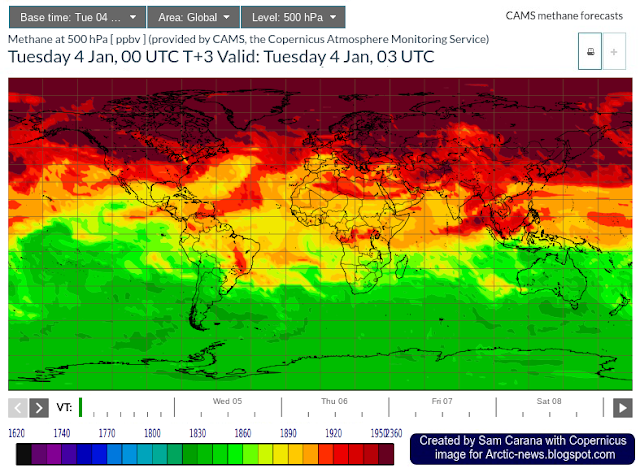NOAA’s September 2021 global mean methane reading is 1900.5 parts per billion (ppb), which is 15.8 ppb higher than the reading for September 2020. By comparison, NOAA’s annual global mean methane increase for 2020 of 15.74 ppb was at the time the highest on record.
Above, a combination image of methane averages between latitudes 60°S and 60°N (top) and annual growth rates for these data (bottom) through to 2021, from a Copernicus news release.
Keep in mind that these are data for the latitude range from 60°S and 60°N, whereas some very high methane concentrations are being recorded over the area within the Arctic Circle (66°30′ N).
Another recent example is the MetOp satellite peak reading on the right of 2854 ppb at 586 mb on January 9, 2022.
The image below is a screenshot of a Copernicus forecast for January 5, 2022, 03 UTC, this time showing methane at surface level and using a Eurasia projection. Note that the darkest-brown color on the scale for surface level indicates methane concentrations above 2160 parts per billion (ppb).
For its surface forecasts, Copernicus appears to use a combination of models and observations, with an emphasis on extrapolating from in situ measurements, which can ignore methane releases from locations where such in situ measurements are lacking, particularly over the Arctic Ocean. By contrast, the animation below of December 31, 2021 am, polar-orbiting MetOp satellite images, from an earlier post, shows the highest methane concentrations first emerging over water at higher latitudes North, rather than over land.
Furthermore, carbon dioxide levels also continue to be very high at Barrow, Alaska, as illustrated by the image below, showing a recent daily average exceeding 430 ppm.
Locally, CO₂ concentration can be even higher. The image below shows a concentration of 440 ppm over the Arctic Ocean at the green circle, as the jet stream crosses the Arctic on January 19, 2022.
CO₂ concentration at Mauna Loa was 420.52 ppm on January 26, 2022. The annual peak for CO₂ is expected to occur about May 2022, so it will still go up a lot higher than this over the next few months.
The danger is that these high concentrations of greenhouse gases over the Arctic will contribute to high temperature anomalies in the Arctic and result in further decline of the snow and ice cover and associated changes to the Jet Stream, causing abrupt methane releases from submarine sediments containing hydrates and chambers of free gas.
The MetOp-B satellite recorded a mean methane level of 1958 ppb on October 25, 2021 am at 295 mb, and when using a 1-year GWP of 200, this translates into 391.6 ppm CO₂e. Together with the above CO₂, that’s 391.6 + 420.52 = 812.12 ppm CO₂e.
Now add an additional 5 Gt of methane from an abrupt eruption of the seafloor, which is only 10% of the 50 Gt that Natalia Shakhova et al. warned about long ago, while 50 Gt is in turn only a small fraction of all the methane contained in sediments in the Arctic. On its own, such an eruption of seafloor methane could raise the global mean methane concentration by almost 2000 ppb which, at a 1-year GWP of 200, would translate into 400 ppm CO₂.
So, that would abruptly cause the joint CO₂e of just two greenhouse gases, i.e. methane and CO₂, to cross the 1200 ppm clouds tipping point, triggering a further 8°C global temperature rise, due to the clouds feedback.
The situation is dire and calls for the most comprehensive and effective action, as described at the Climate Plan.
Links
• NOAA – globally averaged marine surface monthly mean methane data
https://gml.noaa.gov/webdata/ccgg/trends/ch4/ch4_mm_gl.txt
• NOAA – globally averaged marine surface annual mean methane growth rates
• NOAA – Infrared Atmospheric Sounding Interferometer (IASI) Sounding Products (MetOp)
https://www.ospo.noaa.gov/Products/atmosphere/soundings/iasi
• CAMS, the Copernicus Atmosphere Monitoring Service
https://atmosphere.copernicus.eu/charts/cams
• NOAA – Carbon Cycle Gases, Barrow Atmospheric Baseline Observatory, United States
https://gml.noaa.gov/dv/iadv/graph.php?code=BRW
• NOAA – Trends in Atmospheric Carbon Dioxide, Mauna Loa, Hawaii
https://gml.noaa.gov/ccgg/trends/graph.html
• Human Extinction by 2022?
https://arctic-news.blogspot.com/2021/11/human-extinction-by-2022.html
• Climate Plan
https://arctic-news.blogspot.com/p/climateplan.html














